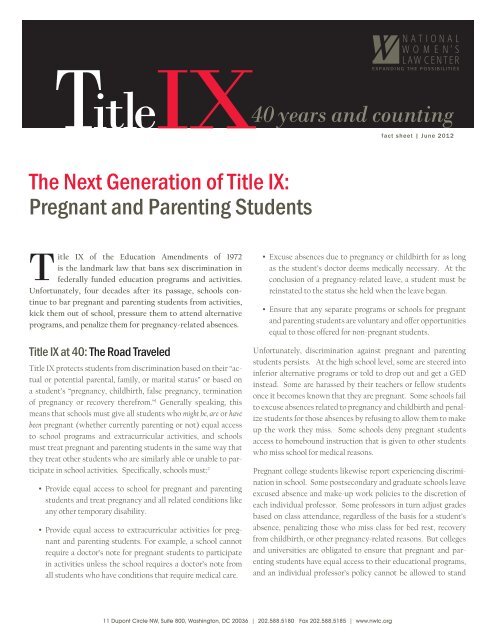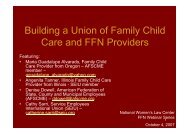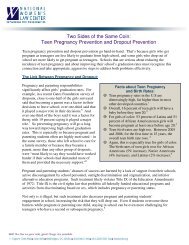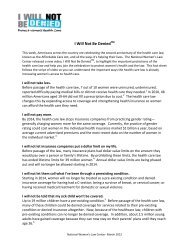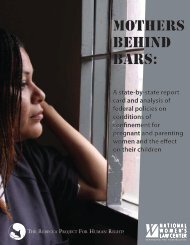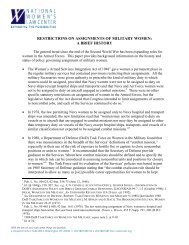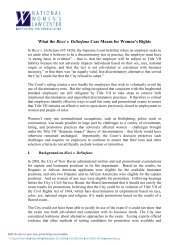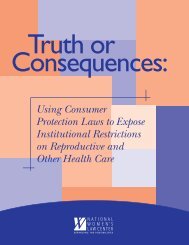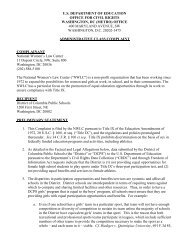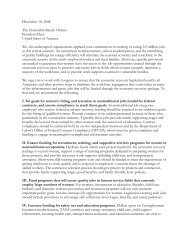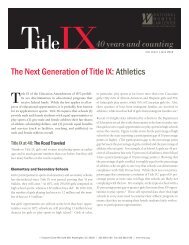The Next Generation of Title IX: Pregnant and Parenting Students
The Next Generation of Title IX: Pregnant and Parenting Students
The Next Generation of Title IX: Pregnant and Parenting Students
You also want an ePaper? Increase the reach of your titles
YUMPU automatically turns print PDFs into web optimized ePapers that Google loves.
TITLE <strong>IX</strong>: PREGNANT ANd PARENTING STUDENTS • FACT SHEET<br />
<strong>Title</strong><strong>IX</strong><br />
fact<br />
<strong>The</strong> <strong>Next</strong> <strong>Generation</strong> <strong>of</strong> <strong>Title</strong> <strong>IX</strong>:<br />
<strong>Pregnant</strong> <strong>and</strong> <strong>Parenting</strong> <strong>Students</strong><br />
40 years <strong>and</strong> counting<br />
sheet | June 2012<br />
<strong>Title</strong> <strong>IX</strong> <strong>of</strong> the Education Amendments <strong>of</strong> 1972<br />
is the l<strong>and</strong>mark law that bans sex discrimination in<br />
federally funded education programs <strong>and</strong> activities.<br />
Unfortunately, four decades after its passage, schools continue<br />
to bar pregnant <strong>and</strong> parenting students from activities,<br />
kick them out <strong>of</strong> school, pressure them to attend alternative<br />
programs, <strong>and</strong> penalize them for pregnancy-related absences.<br />
<strong>Title</strong> <strong>IX</strong> at 40: <strong>The</strong> Road Traveled<br />
<strong>Title</strong> <strong>IX</strong> protects students from discrimination based on their “actual<br />
or potential parental, family, or marital status” or based on<br />
a student’s “pregnancy, childbirth, false pregnancy, termination<br />
<strong>of</strong> pregnancy or recovery therefrom.” 1 Generally speaking, this<br />
means that schools must give all students who might be, are or have<br />
been pregnant (whether currently parenting or not) equal access<br />
to school programs <strong>and</strong> extracurricular activities, <strong>and</strong> schools<br />
must treat pregnant <strong>and</strong> parenting students in the same way that<br />
they treat other students who are similarly able or unable to participate<br />
in school activities. Specifically, schools must: 2<br />
• Provide equal access to school for pregnant <strong>and</strong> parenting<br />
students <strong>and</strong> treat pregnancy <strong>and</strong> all related conditions like<br />
any other temporary disability.<br />
• Provide equal access to extracurricular activities for pregnant<br />
<strong>and</strong> parenting students. For example, a school cannot<br />
require a doctor’s note for pregnant students to participate<br />
in activities unless the school requires a doctor’s note from<br />
all students who have conditions that require medical care.<br />
• Excuse absences due to pregnancy or childbirth for as long<br />
as the student’s doctor deems medically necessary. At the<br />
conclusion <strong>of</strong> a pregnancy-related leave, a student must be<br />
reinstated to the status she held when the leave began.<br />
• Ensure that any separate programs or schools for pregnant<br />
<strong>and</strong> parenting students are voluntary <strong>and</strong> <strong>of</strong>fer opportunities<br />
equal to those <strong>of</strong>fered for non-pregnant students.<br />
Unfortunately, discrimination against pregnant <strong>and</strong> parenting<br />
students persists. At the high school level, some are steered into<br />
inferior alternative programs or told to drop out <strong>and</strong> get a GED<br />
instead. Some are harassed by their teachers or fellow students<br />
once it becomes known that they are pregnant. Some schools fail<br />
to excuse absences related to pregnancy <strong>and</strong> childbirth <strong>and</strong> penalize<br />
students for those absences by refusing to allow them to make<br />
up the work they miss. Some schools deny pregnant students<br />
access to homebound instruction that is given to other students<br />
who miss school for medical reasons.<br />
<strong>Pregnant</strong> college students likewise report experiencing discrimination<br />
in school. Some postsecondary <strong>and</strong> graduate schools leave<br />
excused absence <strong>and</strong> make-up work policies to the discretion <strong>of</strong><br />
each individual pr<strong>of</strong>essor. Some pr<strong>of</strong>essors in turn adjust grades<br />
based on class attendance, regardless <strong>of</strong> the basis for a student’s<br />
absence, penalizing those who miss class for bed rest, recovery<br />
from childbirth, or other pregnancy-related reasons. But colleges<br />
<strong>and</strong> universities are obligated to ensure that pregnant <strong>and</strong> parenting<br />
students have equal access to their educational programs,<br />
<strong>and</strong> an individual pr<strong>of</strong>essor’s policy cannot be allowed to st<strong>and</strong><br />
11 Dupont Circle NW, Suite 800, Washington, DC 20036 | 202.588.5180 Fax 202.588.5185 | www.nwlc.org
TITLE <strong>IX</strong>: PREGNANT ANd PARENTING STUDENTS • FACT SHEET<br />
if it conflicts with <strong>Title</strong> <strong>IX</strong>. Colleges <strong>and</strong> universities also cannot<br />
terminate scholarships based on pregnancy, tell pregnant students<br />
they should drop out or switch programs, or exclude qualified<br />
pregnant students from opportunities to “work in the field,”<br />
through internships, career rotations, or the like.<br />
Why It Matters:<br />
<strong>The</strong> Impact on Women <strong>and</strong> Girls<br />
<strong>The</strong> discrimination that pregnant <strong>and</strong> parenting students face exacerbates<br />
the other barriers they experience in meeting their educational<br />
goals, pushing far too many students out the school house<br />
door. According to a study released in 2010, only about one-half <strong>of</strong><br />
teen mothers get a high school diploma by the age <strong>of</strong> 22, compared<br />
with 89% <strong>of</strong> women who do not have a child during their teen<br />
years. 3 One-third <strong>of</strong> teenage mothers never get a G.E.D. or a diploma.<br />
4 Moreover, less than 2% <strong>of</strong> young teenage mothers attain<br />
a college degree by the age <strong>of</strong> 30. 5<br />
Teen mothers who drop out <strong>of</strong> high school face particularly dire<br />
economic prospects. Overall, females who drop out <strong>of</strong> high school<br />
are more likely to be unemployed than male high school dropouts, 6<br />
<strong>and</strong> those who do find jobs face lower earnings, 7 so as a result, they<br />
are more likely to have to rely on safety net programs to support<br />
themselves <strong>and</strong> their families. 8 By contrast, when pregnant <strong>and</strong><br />
parenting students succeed, it benefits not only them but their<br />
communities <strong>and</strong> our nation as a whole, <strong>and</strong> greatly improves the<br />
chances that their children will graduate <strong>and</strong> achieve economic<br />
security too.<br />
<strong>Next</strong> <strong>Generation</strong> Issue<br />
Breastfeeding accommodations<br />
Although the 2010 Affordable Care Act requires employers to provide<br />
employees with the time <strong>and</strong> space to express breast milk for<br />
at least one year after the birth <strong>of</strong> a child, pregnant <strong>and</strong> parenting<br />
students must confront their school’s unwillingness to accommodate<br />
the need for time <strong>and</strong> space for students to do so. This<br />
can pose a serious hardship for young mothers, because failure to<br />
express breast milk on a set schedule can lead to engorgement,<br />
which causes discomfort, pain, <strong>and</strong> fever, <strong>and</strong> can even lead to infection,<br />
as well as a reduction in the amount <strong>of</strong> breast milk produced.<br />
9 Without the opportunity for breaks <strong>of</strong> the necessary duration,<br />
breastfeeding young women will likely experience extreme<br />
pain <strong>and</strong> discomfort in school, causing a serious distraction that<br />
could negatively impact their ability to learn, <strong>and</strong> posing a risk to<br />
their health. Refusing to accommodate breastfeeding needs also<br />
<strong>Title</strong><strong>IX</strong><br />
<strong>The</strong> Road Ahead<br />
<strong>The</strong> U.S. Department <strong>of</strong> Education’s<br />
Office for Civil Rights (OCR) should<br />
shine a spotlight on this issue <strong>and</strong> send<br />
a message to school districts that they must<br />
take pregnant <strong>and</strong> parenting students’ civil rights<br />
seriously. OCR should: (1) remind schools <strong>and</strong><br />
districts <strong>of</strong> their legal obligations to pregnant <strong>and</strong><br />
parenting students <strong>and</strong> instruct them to get into<br />
compliance; (2) conduct proactive <strong>Title</strong> <strong>IX</strong><br />
compliance reviews with this focus; <strong>and</strong><br />
(3) include data on pregnant <strong>and</strong> parenting<br />
students in the Civil Rights Data Collection.<br />
Legislation pending in Congress,<br />
<strong>The</strong> <strong>Pregnant</strong> <strong>and</strong> <strong>Parenting</strong> <strong>Students</strong><br />
Access to Education Act, 10 would give states<br />
<strong>and</strong> school districts support to provide services<br />
that promote the educational success <strong>of</strong><br />
pregnant <strong>and</strong> parenting students.<br />
Schools should make sure they have<br />
designated a <strong>Title</strong> <strong>IX</strong> coordinator,<br />
a position required in every school <strong>and</strong> district,<br />
<strong>and</strong> ask the coordinator to act as a liaison for<br />
pregnant <strong>and</strong> parenting students to ensure<br />
they get the services they need to succeed –<br />
including, when applicable, the time <strong>and</strong><br />
space to express breast milk.<br />
11 Dupont Circle NW, Suite 800, Washington, DC 20036 | 202.588.5180 Fax 202.588.5185 | www.nwlc.org
TITLE <strong>IX</strong>: PREGNANT ANd PARENTING STUDENTS • FACT SHEET<br />
sends students the message that being a mother is incompatible<br />
with educational success.<br />
Women who are nursing should not be forced to choose between<br />
going to school under disadvantageous conditions that place their<br />
health – <strong>and</strong> their academic success – at risk <strong>and</strong> postponing their<br />
education until they are no longer breastfeeding. To ensure that<br />
young mothers are not put in that position, schools should provide<br />
students with breaks <strong>of</strong> the necessary duration as well as a<br />
clean, private space (that is not a restroom) to express breast milk.<br />
1 20 U.S.C. §§ 1681 et seq. (2006); 34 C.F.R. § 106.40.<br />
2 Id.<br />
3 KATE PERPER, KRISTEN PETERSON & JENNIFER MANLOVE, CHILD TRENDS, DIPLOMA ATTAINMENT AMONG TEEN MOTHERS 1 (2010), available at http://www.childtrends.org/Files/<br />
Child_Trends-2010_01_22_FS_DiplomaAttainment.pdf.<br />
4 Id.<br />
5 HOFFMAN, S.D., THE NATIONAL CAMPAIGN TO PREVENT TEEN PREGNANCY, By the Numbers: <strong>The</strong> Public Costs <strong>of</strong> Adolescent Childbearing (2006).<br />
6 Bureau <strong>of</strong> Labor Statistics, Current Population Survey, available at http://data.bls.gov/cgi-bin/srgate (last visited May 10, 2012). In 2011, women 25 <strong>and</strong> older without a high<br />
school diploma had an unemployment rate <strong>of</strong> 14.8 percent, compared to 13.6 percent for men 25 <strong>and</strong> older without a high school diploma. Data were accessed using codes<br />
LNU04027675 (men) <strong>and</strong> LNU04027679 (women).<br />
7 U.S. Census Bureau, Current Population Survey (CPS), 2011 Annual Social <strong>and</strong> Economic Survey, Table PINC-03:Educational Attainment – People 25 Years Old <strong>and</strong> Over, by Total<br />
Money Earnings in 2010, Work Experience in 2010, Age, Race, Hispanic Origin, <strong>and</strong> Sex, available at http://www.census.gov/hhes/www/cpstables/032011/perinc/new03_000.<br />
htm [hereinafter Educational Attainment Table]. Earnings data are for men <strong>and</strong> women 25-64 who worked full time, year round. <strong>The</strong> typical woman who started, but did not finish<br />
high school had earnings <strong>of</strong> $20,779, just 71 percent <strong>of</strong> her male counterpart’s earnings ($29,076).<br />
8 NWLC calculations using U.S. Census Bureau, Current Population Survey, 2011 Annual Social <strong>and</strong> Economic Survey, public-use microdata files. Calculations based on receipt <strong>of</strong> WIC,<br />
SSI, <strong>and</strong> TANF. Medicaid data from U.S. Census Bureau, Current Population Survey, CPS Table Creator, available at http://www.census.gov/cps/data/cpstablecreator.html<br />
(last visited May 10, 2012).<br />
9 See, e.g., U.S. Dep’t <strong>of</strong> Health <strong>and</strong> Human Services, Office <strong>of</strong> Women’s Health, Your Guide to Breastfeeding 34 (2011), http://www.womenshealth.gov/publications/our-publications/breastfeeding-guide/BreastfeedingGuide-General-English.pdf.<br />
10 <strong>Pregnant</strong> <strong>and</strong> <strong>Parenting</strong> <strong>Students</strong> Access to Education Act, H.R. 2617, 112th CONGRESS (2011).<br />
11 Dupont Circle NW, Suite 800, Washington, DC 20036 | 202.588.5180 Fax 202.588.5185 | www.nwlc.org


